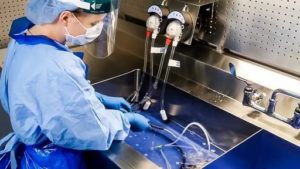 With endoscope cleaning procedures continuing to be a focus for hospitals emphasizing patient safety, the Joint Commission has also increased its scrutiny of reprocessing protocols at its member hospitals. In order to minimize the chances of using poorly reprocessed endoscopes, hospitals should concentrate on understanding endoscope instructions for use and knowing the evidence-based guidelines put out by the associations concerned with the best ways to high-level disinfect endoscopes. As this article at Gastroenterology and Endoscopy News explains:
With endoscope cleaning procedures continuing to be a focus for hospitals emphasizing patient safety, the Joint Commission has also increased its scrutiny of reprocessing protocols at its member hospitals. In order to minimize the chances of using poorly reprocessed endoscopes, hospitals should concentrate on understanding endoscope instructions for use and knowing the evidence-based guidelines put out by the associations concerned with the best ways to high-level disinfect endoscopes. As this article at Gastroenterology and Endoscopy News explains:
“The key phrase in reprocessing is “follow the manufacturer’s IFU,” Ms. [Nancy S. Schlossberg, RN, CER] added.
To prevent human errors, she recommended that all technicians be certified and follow proper hand hygiene and personal protective equipment protocols. Nurse managers should document competency and training protocols at regular intervals, starting with orientation, and at least annually or after release of institutional policies and procedures and/or professional society recommendations. Lack of quality control measures can lead to infection and endoscope damage, she added.
For evidence-based guidelines, there are a number of options, including those from SGNA, AORN, the FDA, the CDC and the American National Standards Institute/AAMI, among others. Staff should be well versed in the guidelines and updated when new alerts are issued.
Retaining staff can become an issue. “Insufficient staff and resources to support the volume and workflow can disrupt reprocessing, lead to delays in reprocessing scopes, and pose potential infection risks to patients,” she noted.
Joint Commission Tightening Reins
In the first half of 2018, the Joint Commission cited 72% of hospitals and 60% of ambulatory surgery centers for noncompliance. Reasons given included not adhering to manufacturers’ IFU, not following evidence-based guidelines, lack of validation of competency, lack of competent oversight by area manager, and lack of involvement of infection prevention staff. In September 2018, the Joint Commission revised the scoring in seven areas related to HLD and sterilization. The common theme, according to Ms. Schlossberg, was “establishing processes that support manufacturers’ IFU instructions.”
For microbial surveillance of duodenoscopes, the FDA and CDC recommend traditional culturing. Although SGNA does not recommend routine culturing, many institutions have adopted this practice to enhance patient safety, Ms. Schlossberg noted. If a scope tests positive, SGNA recommends that the scope undergo repeat HLD followed by liquid chemical sterilization, if needed.
Ms. Schlossberg noted that cleaning verification tests including adenosine triphosphate and protein, carbohydrate, and hemoglobin do not equal surveillance. “Cleaning tests measure levels of organic debris remaining on the device following manual cleaning. Microbiological sampling and culturing detect bacterial contamination remaining on a scope following high-level disinfection. Surveillance sampling and culturing can send an early alert of potential problems with reprocessing quality,” she said.”
Read the entire article here: Tips for Avoiding Poor Compliance Grades
Hospitals must ensure that they’re doing everything they can to protect themselves and their patients from harm. The article points out that hospitals must focus on ensuring their staff is following established evidence-based guidelines and avoiding human error. Make sure that your staff is following the proper processes and protocols each and every time an endoscope is reprocessed. Endoscope tracking systems such as iRIScope can display the proper workflow for reprocessing endoscopes and document the process electronically. Any breaches of protocol can be discovered in real-time to protect patients and identify which staff members need additional training on reprocessing techniques. You owe it to your staff and your patients to offer everyone the peace of mind that flexible endoscopes are being properly reprocessed every single time.
